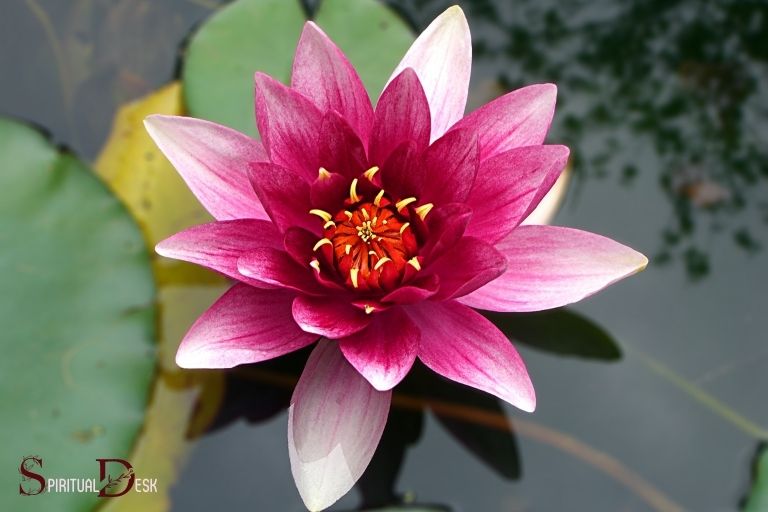What Is The Spiritual Meaning Of The Lotus Flower? Rebirth!
The spiritual meaning of the Lotus Flower is deeply embedded in various religions and cultures, symbolizing purity, enlightenment, rebirth, and self-regeneration.
In Hinduism and Buddhism, the Lotus Flower is considered sacred and holds high spiritual significance.
It grows in muddy water, and it is this environment that provides the metaphorical foundation for its symbolism.
Rising and blooming out of the murk symbolizes a journey from darkness (ignorance) to light (knowledge and wisdom).
The Lotus Flower is a fascinating symbol of our own spiritual path.
It starts its journey in the mud (representing ignorance) and grows towards the light (signifying knowledge and wisdom), eventually emerging above the surface in full bloom, representing the enlightened self.
Despite growing in muddy waters, it remains unstained, symbolizing the purity of the soul.
7 Aspects: Spiritual Meaning of the Lotus Flower
| Symbolism Aspect | Spiritual Meaning of the Lotus Flower |
|---|---|
| Purity | The lotus flower represents purity of the body, speech, and mind, as it emerges from murky waters unblemished and untainted by the mud around it. |
| Enlightenment | The lotus flower symbolizes the journey from darkness to light, as it grows from muddy waters towards the sun, representing spiritual awakening and the path to enlightenment. |
| Resilience | The lotus flower is resilient and can survive in challenging environments, symbolizing the strength and perseverance needed to overcome obstacles on the spiritual path. |
| Transformation | The lotus flower undergoes a dramatic transformation from a small bud to a beautiful, fully bloomed flower, representing the transformation and growth of an individual on their spiritual journey. |
| Rebirth | The lotus flower closes at night and sinks underwater, only to re-emerge and bloom again the next day. This daily cycle represents the concept of rebirth and the idea of spiritual renewal. |
| Divine Beauty | The lotus flower is often associated with divine beauty and grace, symbolizing the purity and perfection of the enlightened mind. |
| Chakras | In Hinduism and Buddhism, the lotus flower is associated with various chakras or energy centers in the body, representing the opening and balancing of these centers for spiritual growth. |
Key Takeaway

Five Facts About: The Spiritual Meaning of the Lotus Flower
Understanding The Lotus Flower’s Significance In Spirituality
The lotus flower holds immense spiritual significance across various cultures and religions. It is a symbol of beauty, purity, and enlightenment.
We will delve deeper into the historical and cultural importance of the lotus flower in spiritual practices, as well as explore how it represents universal enlightenment and purity.
Historical And Cultural Importance Of The Lotus Flower In Spiritual Practices:
- Ancient egyptians revered the lotus as a symbol of creation and rebirth. They believed that the flower emerged from the primeval waters, representing the birth of the sun god.
- In hinduism, the lotus is associated with various deities, including goddess lakshmi and lord vishnu. It symbolizes purity and divine beauty, while also representing the chakras and the journey towards spiritual awakening.
- Buddhism often depicts deities seated on or holding lotus flowers. The lotus represents the path to enlightenment, as it grows out of muddy waters, yet remains pure and untouched.
- The lotus also holds significance in chinese and japanese cultures. It is seen as a symbol of purity and spiritual development, closely associated with buddhism and daoism.
How The Lotus Flower Is A Universal Symbol Of Enlightenment And Purity:
- The lotus flower’s ability to grow and blossom in murky and muddy waters signifies the potential for spiritual growth and transformation amidst challenging circumstances. It serves as a reminder that one can rise above their surroundings and attain enlightenment.
- The lotus’s unfolding petals symbolize the gradual opening of one’s consciousness and the expansion of knowledge and wisdom.
- The purity of the lotus flower is often associated with the purity of the mind and spirit. Just like the lotus remains unstained by the muddy waters, individuals strive to purify their thoughts and actions to achieve spiritual enlightenment.
- The lotus is also connected to the concept of detachment, as it remains rooted in the water but remains unaffected by it. It encourages individuals to cultivate detachment from worldly desires and attachments in their spiritual journey.
Throughout history, the lotus flower has served as a powerful symbol in spirituality, representing purity, enlightenment, and the potential for spiritual growth.
By understanding its historical and cultural significance, as well as its universal symbolism of purity and enlightenment, we can gain deeper insights into the spiritual meaning of the lotus flower.
Unveiling The Lotus Flower’S Symbolic Meaning In Different Religions
The lotus flower is a captivating and mystical entity that holds profound meaning in various religions and mythologies around the world.
Its symbolic significance can be observed in hinduism, buddhism, and even egyptian mythology. Let’s delve into the spiritual meaning of the lotus flower in different faiths.
The Lotus Flower In Hinduism: A Representation Of Divinity And Eternity
- The lotus flower, known as the “padma” in sanskrit, holds paramount importance in hinduism.
- In hindu mythology, the lotus is associated with numerous gods and goddesses, symbolizing divinity, purity, beauty, and grace.
- It represents the divine beauty and manifestation of the gods and goddesses.
- The unfolding petals of the lotus are analogous to the divine unfoldment of one’s soul and spiritual growth.
- Lord vishnu, the preserver and protector of the universe, is often portrayed resting on a lotus flower, signifying his supreme power and authority.
- The significance of the lotus in hindu rituals and ceremonies is profound, as it denotes purity of thoughts, actions, and speech.
The Lotus Flower In Buddhism: Symbolizing Purity, Enlightenment, And The Path To Nirvana
- Buddhism holds the lotus as a sacred flower, illustrating its crucial role in the teachings of buddha.
- The lotus is seen as a metaphor for the journey towards enlightenment and the path to nirvana.
- Similar to the lotus emerging from muddy waters, buddha emphasized the possibility for individuals to rise above suffering and attain enlightenment.
- The purity and serenity of the lotus flower symbolize the purity of the buddha’s mind and the state of enlightenment.
- Different colors of the lotus in buddhist art convey various symbolism. For instance, a white lotus represents spiritual perfection, while a pink lotus symbolizes the buddha himself.
- The lotus is often depicted in buddha’s hand or as a throne, exemplifying his enlightened state and radiating peace and tranquility.
The Lotus Flower In Egyptian Mythology: A Symbol Of Creation And Rebirth
- Ancient egyptian mythology associates the lotus flower with creation, rebirth, and the cycle of life.
- The egyptian blue water lily, also called the blue lotus or nymphaea caerulea, was regarded as a sacred plant and was considered a symbol of resurrection.
- The blooming of the lotus in the morning represented the rising sun and the creation of the world.
- The closing of the lotus at night signified the setting sun and death, followed by its reemergence the next day, representing rebirth and the eternal nature of life.
- In egyptian art and hieroglyphics, the lotus is depicted as a decorative motif on temples, thrones, and jewelry, signifying the regenerative power of the divine.
The lotus flower’s spiritual meaning transcends religious boundaries and connects humanity through its symbolism of purity, divinity, enlightenment, and rebirth.
Its exquisiteness and graceful presence in these beliefs illustrate the universal fascination and admiration for the lotus, making it a profound and timeless symbol of the human journey towards spiritual awakening.
Exploring The Lotus Flower’S Sacred Geometry And Chakra Connection
The unique structure of the lotus flower and its association with sacred geometry:
The lotus flower, with its exquisite beauty and distinct shape, holds a significant place in various cultures and spiritual practices.
Its mesmerizing structure is closely linked to the concept of sacred geometry, representing harmony and balance in the natural world.
Here’s what you need to know about the lotus flower’s sacred geometry:
- The lotus flower possesses a unique structure that symbolizes purity and enlightenment. Its petals, which are delicately arranged in concentric circles, create a mesmerizing spiral pattern that draws the eye inward.
- This spiral pattern is known as the fibonacci sequence, a mathematical concept found in nature’s growth patterns. The fibonacci sequence is a series of numbers in which each number is the sum of the two preceding ones (0, 1, 1, 2, 3, 5, 8, and so on). It is through this divine ratio that the mesmerizing spiral arrangement of the lotus petals emerges.
- The fibonacci sequence is also connected to the golden ratio, often expressed as 1.618. This ratio is considered aesthetically pleasing, and its presence in the lotus flower’s structure adds to its sacredness. The golden ratio is found in various objects of beauty and harmony, such as architecture and art.
- The sacred geometry of the lotus flower symbolizes the journey of spiritual awakening. Just as the lotus rises from muddy waters to bloom into a stunning flower, individuals strive to transcend their limitations and blossom into their true selves. The spiral arrangement of the petals represents this continuous growth and expansion towards enlightenment.
Aligning the lotus flower with the seven chakras and their spiritual significance:
The lotus flower’s symbolism goes beyond its sacred geometry. It is also closely associated with the seven chakras, the energy centers within the body. Each chakra is believed to correspond to specific aspects of our physical, emotional, and spiritual well-being.
Let’s explore how the lotus flower aligns with each chakra:
- Root chakra (muladhara): The root chakra represents stability, grounding, and our connection to the earth. The lotus flower, with its roots firmly anchored in the muddy depths, reflects the importance of a strong foundation for our spiritual journey.
- Sacral chakra (svadhisthana): The sacral chakra governs creativity, sensuality, and emotional balance. The lotus flower’s vibrant colors and graceful form resonate with the energy of this chakra, symbolizing the free flow of creativity and emotional expression.
- Solar plexus chakra (manipura): The solar plexus chakra relates to our personal power, self-confidence, and willpower. Just as the lotus flower shines with its radiant petals, this chakra empowers us to radiate our authentic selves and assert our inner strength.
- Heart chakra (anahata): The heart chakra is the center of love, compassion, and emotional healing. The lotus flower, often associated with purity and divine love, represents the blossoming of unconditional love within our hearts.
- Throat chakra (vishuddha): The throat chakra governs communication, self-expression, and authenticity. The lotus flower’s petals unfolding in a harmonious manner symbolize our ability to speak our truth with clarity and integrity.
- Third eye chakra (ajna): The third eye chakra is associated with intuition, insight, and spiritual awakening. The lotus flower’s connection to the third eye chakra signifies the blossoming of our inner wisdom and heightened spiritual perception.
- Crown chakra (sahasrara): The crown chakra represents our connection to the divine, spiritual consciousness, and enlightenment. Just like the fully bloomed lotus flower reaching towards the sky, this chakra’s alignment with the lotus signifies the ultimate union with the divine.
By understanding the unique structure and sacred geometry of the lotus flower, as well as its alignment with the seven chakras, we can deepen our appreciation for its profound spiritual significance.
The lotus flower serves as a reminder of our own potential for growth, transformation, and spiritual awakening.
Let its symbolism inspire us to embrace our journey and strive for enlightenment.
Unraveling The Color Symbolism Of The Lotus Flower
The Various Colors Of Lotus Flowers And Their Spiritual Meanings
The lotus flower is not only a visually stunning and captivating plant, but it also holds deep spiritual significance in many cultures and religions.
One of the most intriguing aspects of the lotus flower is its wide range of colors, each carrying its own symbolism.
Let’s delve into the different colors of lotus flowers and explore their spiritual meanings.
Red Lotus Flower: Passion And Love
- Symbolizes passionate love, desire, and compassion.
- Represents the heart and intense emotions.
- It is often associated with the goddess of love, compassion, and fertility.
Pink Lotus Flower: Beauty And Purity
- Represents purity of the mind and spirit.
- Symbolizes gentleness, grace, and innocence.
- Often associated with the supreme goddesses and the divine feminine.
Blue Lotus Flower: Enlightenment And Wisdom
- Symbolizes a state of tranquility and spiritual enlightenment.
- Represents the victory of the spirit over the senses.
- Often associated with the awakened mind and the attainment of knowledge.
White Lotus Flower: Spiritual Awakening And Purity
- Symbolizes purity of the mind, spirit, and the highest level of enlightenment.
- Represents spiritual perfection and the awakening of the soul.
- Associated with deities and spiritual figures who have attained divine realization.
Yellow Lotus Flower: Spiritual Enlightenment And Wisdom
- Symbolizes spiritual ascension and the enlightenment of one’s inner self.
- Represents knowledge, wisdom, and the highest state of spiritual consciousness.
- Often associated with the sun and celestial beings.
Purple Lotus Flower: Mysticism And Spirituality
- Symbolizes mysticism, spiritual awakening, and occult knowledge.
- Associated with higher realms of consciousness and spiritual insight.
- Often linked to spiritual practices and the pursuit of spiritual growth.
Gold Lotus Flower: Divine Illumination And Royalty
- Symbolizes the highest state of enlightenment and divine illumination.
- Represents wealth, abundance, and spiritual royalty.
- Often associated with deities and enlightened beings who radiate golden light.
Black Lotus Flower: Transformation And Rebirth
- Symbolizes transformation, renewal, and spiritual rebirth.
- Represents the overcoming of obstacles and the emergence of inner power.
- Often associated with spiritual journeys and the exploration of the shadow self.
Green Lotus Flower: Health And Renewal
- Symbolizes vitality, growth, and rejuvenation.
- Represents physical and emotional healing.
- Often associated with nature, fertility, and the cycle of life.
Understanding the color symbolism of lotus flowers allows us to appreciate their spiritual significance even more.
Whether it’s the passionate red, the pure white, or the enlightening blue, each color carries its own unique message, inviting us to explore the depths of our spirituality and embark on a transformative journey of self-discovery.
Harnessing The Spiritual Power Of The Lotus Flower In Personal Growth
Using The Lotus Flower As A Symbol For Personal Transformation And Growth
The lotus flower is notjust a beautiful flower; it also carries deep spiritual symbolism.
In many cultures and religions, the lotus flower is considered a powerful symbol of personal transformation and growth.
This ancient symbol teaches us valuable lessons about resilience, enlightenment, and the journey of the soul.
By harnessing the spiritual power of the lotus flower, we can unlock our inner potential and experience profound personal growth.
Here are key points to consider when using the lotus flower as a symbol for personal transformation and growth:
- Embracing resilience: The lotus flower grows in muddy and murky waters, yet it rises above the surface to bloom in all of its glory. This symbolizes the power of resilience and the ability to overcome challenges. By acknowledging that growth often comes from difficult circumstances, we can find strength in our own journey of personal transformation.
- Embodying enlightenment: Just as the lotus flower emerges from the darkness of the mud, it represents the journey towards spiritual enlightenment. This symbol reminds us that growth and self-discovery often require us to delve into the depths of our being. By embracing introspection and self-reflection, we can tap into the transformative power of the lotus flower.
- Cultivating inner beauty: The lotus flower is admired for its outer beauty, but its true essence lies within. This symbol teaches us to nurture our inner beauty and embrace our authentic selves. By focusing on personal growth and self-improvement, we can blossom into the best version of ourselves, radiating positivity and grace.
Practical Tips And Rituals To Incorporate The Lotus Flower’S Spiritual Energy Into Everyday Life
To harness the spiritual energy of the lotus flower in your personal growth journey, you can incorporate practical tips and rituals into your daily life.
These simple practices will help you connect with the deeper meaning of the lotus flower and promote personal transformation:
- Meditation and visualization: Start your day by meditating on the image of a blooming lotus flower. Visualize yourself embracing the qualities of the lotus, such as resilience and enlightenment. By immersing yourself in this visual imagery, you can inspire personal growth and set positive intentions for the day ahead.
- Creating a lotus flower altar: Set up a dedicated space in your home for a lotus flower altar. Arrange fresh lotus flowers or images of lotus flowers in a serene and sacred manner. This sacred space will serve as a reminder of your personal growth journey and provide a focal point for reflection, gratitude, and self-discovery.
- Journaling and affirmations: Incorporate lotus-inspired journaling prompts into your daily writing practice. Reflect on the lessons you’ve learned, the challenges you’ve overcome, and the personal growth you’re experiencing. Additionally, incorporate lotus-inspired affirmations into your daily affirmations practice.
- Surrounding yourself with lotus symbolism: Fill your living space with lotus-inspired decor and symbolic items. Surround yourself with lotus artwork, sculptures, or even wear lotus flower jewelry as a constant reminder of your personal growth journey. These visual cues can help shift your mindset and align your energy with the transformative power of the lotus flower.
Remember, the spiritual meaning of the lotus flower goes beyond its physical beauty.
By incorporating its symbolism into your daily life through practical tips and rituals, you can tap into its spiritual energy for personal transformation and growth.
Embrace the resilience, enlightenment, and inner beauty that the lotus flower represents, and let it guide you on your journey towards self-discovery and personal growth.
FAQ About Spiritual Meaning Of The Lotus Flower?
What Is The Spiritual Meaning Of The Lotus Flower?
The spiritual meaning of the lotus flower represents purity, enlightenment, and spiritual growth.
How Does The Lotus Symbolize Purity?
The lotus symbolizes purity because it grows in muddy waters but blooms above the surface, untouched by impurities.
What Does The Lotus Flower Represent In Buddhism?
In buddhism, the lotus flower represents enlightenment, spiritual awakening, and the transcendence of suffering.
Is The Lotus Flower A Symbol Of Rebirth?
Yes, the lotus flower is often seen as a symbol of rebirth and renewal because it closes at night and reopens in the morning.
Are There Different Colors Of Lotus Flowers And Their Meanings?
Yes, different colors of lotus flowers hold different meanings. For example, a pink lotus symbolizes love and compassion, while a white lotus represents purity and spiritual perfection.
Conclusion
The lotus flower holds deep spiritual significance across various cultures and religions. Its beauty and resilience symbolize spiritual enlightenment, purity, and the awakening of one’s true self.
In hinduism and buddhism, the lotus represents the journey of the soul, rising above muddy waters to bloom into a state of enlightenment.
This majestic flower’s ability to grow in unfavorable conditions teaches us resilience and strength in the face of adversity.
Its unfolding petals exemplify spiritual growth and the expansion of consciousness. The spiritual meaning of the lotus flower reminds us to embrace our inner beauty and to strive for personal and spiritual growth.
As we navigate the challenges of life, the lotus flower serves as a powerful reminder of our infinite potential and the transformative power of the human spirit.
Allow the spiritual essence of the lotus to inspire you to live a life of purpose, compassion, and enlightenment.
Bonus: Spiritual Meaning Of The Lotus Flower
What Is The Power Of The Lotus Flower?
The lotus flower is a sacred symbol in many Eastern religions, including Hinduism and Buddhism.
It is often associated with purity, spiritual awakening, and enlightenment.
The lotus grows in muddy water and emerges unscathed, symbolizing the ability to rise above the muck of worldly desires and attain spiritual perfection.
The petals of the lotus flower are believed to represent the different stages of human development: from the bottommost petal (representing birth) to the middle petals (representing growth and change), to the topmost petal (representing enlightenment).
The journey from the bottom to the top is not an easy one � it requires great effort and perseverance.
But once you reach the top, you will be rewarded with unparalleled beauty and peace.
What Are The 3 Meanings Of Lotus?
In Buddhism, the lotus is often used to symbolize divine birth, spiritual enlightenment, and purity of the heart.
The three petals of the lotus represent the Three Jewels of Buddhism: the Buddha, Dharma, and Sangha.
The lotus is also a symbol of rebirth and resurrection in many cultures, as its flowers bloom in muddy waters and rise up to the surface.
In Egyptian mythology, for example, the lotus was associated with the sun god Ra, who was born from a lotus flower growing in Nun (the primordial waters).
The lotus is also a popular motif in Hinduism and yoga. In Hinduism, it is associated with Lakshmi, the goddess of wealth and prosperity.
In yoga, the lotus position (padmasana) is considered to be one of the most stable and comfortable seated positions for meditation.
What Does A White Lotus Symbolize?
A white lotus symbolizes purity, spiritual awakening, and enlightenment. The lotus is a sacred flower in many cultures and religions, including Buddhism, Hinduism, and Sikhism.
In the Buddhist tradition, the Buddha is often depicted sitting on a lotus throne or holding a lotus flower.
The Lotus Sutra, one of the most important texts in Mahayana Buddhism, is named after the flower. In Hinduism, the goddess Lakshmi is often associated with the white lotus.
What Is The Biblical Meaning Of Lotus?
When it comes to the biblical meaning of lotus, there are a few different interpretations.
Some people believe that the lotus is a symbol of purity and innocence, while others believe that it represents new beginnings and hope.
No matter what your personal beliefs are, there is no denying that the lotus is a beautiful and intriguing flower.
In the Bible, the lotus is mentioned in both the Old Testament and the New Testament.
In Exodus, Moses was instructed by God to have Aaron gather up some of the ashes of a red heifer and throw them into a river.
When Aaron did as he was told, Lotuses sprang up from the water (Exodus 7:19).
This event was seen as a sign of God’s power and His ability to make something beautiful grow out of something seemingly dead.
In the New Testament, Jesus compares His followers to lilies when He says “Consider the lilies how they grow: they toil not, they spin not; and yet I say unto you, that Solomon in all his glory was not arrayed like one of these” (Luke 12:27).
Just as lilies are pure and lovely flowers, so too are those who follow Christ.
Lotus Flower Symbolism
In Buddhism, the lotus is associated with the Buddha himself. The story goes that when the Buddha was born, a lotus bloomed from his navel.
The petals of the flower are said to represent the different levels of enlightenment that one can achieve.
In ancient Egypt, the lotus was a symbol of rebirth and regeneration. This is because the flowers would often grow in murky waters but still manage to produce beautiful blooms.
For this reason, they were often used in funerary rites and tomb decorations.
The Hindus also have a strong connection to the lotus flower. It is seen as a sacred symbol of their goddess Lakshmi.
She is often depicted sitting on a lotus or holding one in her hand. The flower is also said to represent her divine qualities of beauty, grace, and purity.
Lotus Flower With Three Dots Meaning
The lotus flower is a symbol of purity and rebirth in many cultures. In Buddhism, the lotus is often used to represent the Buddha himself.
The three dots on the flower usually represent the Three Jewels of Buddhism: the Buddha, Dharma (the teachings), and Sangha (the community of monks and nuns). Together, these three symbols represent the path to enlightenment.
Lotus Flower Color Meaning
The color of a lotus flower can have different meanings depending on the culture.
In China, for example, the pink lotus is associated with femininity and grace, while the white lotus is associated with purity and spiritual enlightenment. The blue lotus is also sometimes seen as a symbol of serenity.
Lotus Meaning in English
When most people think of the lotus flower, they envision its beauty and grace. The lotus is a popular symbol in many cultures, often representing purity, new beginnings, and spiritual enlightenment.
In fact, the lotus has a long history of symbolism in both Eastern and Western cultures.
The lotus grows in muddy water and yet emerges pristine and untouched by the dirt and grime around it.
This represents the ability to rise above difficult circumstances and emerge as a better person. The lotus is also associated with new beginnings because it blooms anew each morning.
The meaning of the lotus flower can vary depending on its color. For example, white lotuses are typically associated with purity and spiritual awakening, while pink lotuses are more likely to represent compassion or love.
Blue lotuses sometimes symbolize wisdom or knowledge, while purple ones often represent mystical powers or energies.
7 Petal Lotus Meaning
The 7-petal lotus is a sacred symbol in Hinduism and Buddhism. It is often seen as a symbol of enlightenment, purity, and spiritual awakening. The lotus is also associated with the sun and the cosmos.
In the Buddhist tradition, the 7-petal lotus is sometimes referred to as the “Buddha’s footprint”, as it is believed to represent the Buddha’s path to enlightenment. The 7-petal lotus flower has many different meanings in different cultures.
In Hinduism, it is a symbol of knowledge and wisdom.
In Buddhism, it represents purity, spiritual awakening, and enlightenment.
In Egyptian mythology, the lotus was associated with the sun god Ra and represented rebirth and regeneration.
In ancient Greece, the lotus was a symbol of beauty and elegance. The Roman goddess Venus was often depicted holding a lotus flower or standing on top of one.
Lotus flowers were also used in ancient Egyptian funerary rites – they were thought to help guide the soul to its next life after death.
Today, the 7-petal lotus continues to be an important symbol in many cultures around the world.
Lotus Flower Meaning Strength
The lotus flower has also been used as a symbol of strength and perseverance in many different cultures.
The lotus blooms in spite of harsh conditions, representing our own inner strength and ability to overcome adversity.
When we are faced with difficult times, we can remember the flower and draw on our own inner reserves of strength to get through them.
Lotus Flower Meaning In Hinduism
In Hinduism, the lotus flower is often associated with the goddess Lakshmi. The lotus is also considered to be a symbol of wealth, beauty, and fertility.
Pink Lotus Flower Meaning
Most people are familiar with the lotus flower, but did you know that there is such a thing as a pink lotus?
This beautiful flower is actually quite rare, and it has its own special meaning. The pink lotus is often associated with the Buddhist religion.
In fact, it is sometimes called the �Buddha Flower�. The reason for this is that the Buddha was born from a pink lotus. Therefore, the pink lotus represents enlightenment and spiritual awakening.
In addition to its religious significance, the pink lotus also symbolizes love and compassion. This is because the color pink is traditionally associated with these qualities.
If you give someone a pink lotus, it shows that you care about them deeply and want them to achieve their highest potential.
If you�re looking for a unique way to show someone you care, consider giving them a pink lotus flower. It�s sure to make a lasting impression!






